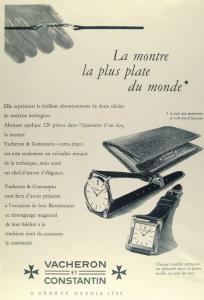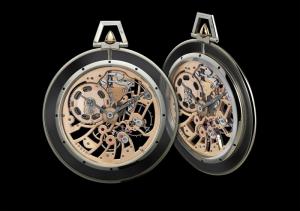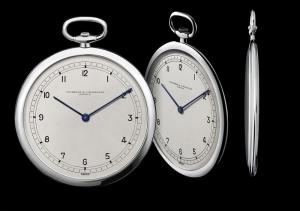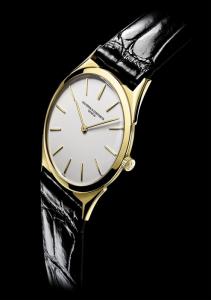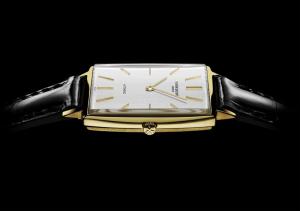Preview SIHH 2010 – Ultra-fines watches – The Vacheron Constantin heritage
The ultra-thin heritage
Vacheron Constantin has chosen today to revive some of the finest moments in the quest for ultra-thinness. The Geneva-based manufacturer has indeed been closely involved in the epic milestones of this distinctive form of expertise, such as in the 1950s and 1960s when Vacheron Constantin introduced the world’s thinnest wristwatches.
Today, Vacheron Constantin is enriching its “Historiques” collection with two new creations directly inspired by its heritage, each imbuing one of two legendary calibres with a new and distinctively modern touch.
“Historique Ultra-fine 1955”
equipped with the mechanical hand-wound 1003 movement the thinnest in the world at just 1.64 mm thick, rebuilt for this model in 18-carat gold, and bearing the Hallmark of Geneva
&
“Historique Ultra-fine 1968”
equipped with the ultra-thin mechanical self-winding 1120 movement featuring a new decorated oscillating weight, and bearing the Hallmark of Geneva
Vacheron Constantin was founded in 1755 and can legitimately claim to be the world’s oldest watch manufacturer still in activity, with over 250 years of continuous expertise and production behind it. A truly unique status within the watch industry.
This proud heritage cultivated over a quarter of a millennium is punctuated with timepieces and movements that have each in their own way left an indelible imprint on their era. This stunning and inestimably valuable patrimony, through which the brand’s history is inextricably bound up with that of the watch industry, eloquently testifies to the brand’s consistent technical and aesthetic creativity.
Evolving in step with new inventions, techniques and of course with the tastes of horological enthusiasts, Vacheron Constantin has explored all fields of the watchmaking art, including pocket-watches and wristwatches, as well as ring-watches, pendant-watches, and brooch-watches. Its range encompasses highly complicated models, automatons, sophisticated clocks, as well as an area which is less conspicuous yet requires an incredible wealth of expertise, experience and talent: that of ultra-thin mechanical movements.
Extreme slenderness is traditionally not considered as a horological complication, in that it does not itself contribute an additional watch function in the same way as a date or a chronograph. It would nonetheless be entirely legitimate to describe it as such, due to its highly complex nature that often pushes micromechanical boundaries to the limit. Although many try their hand in this field, few are successful.
While the first ultra-thin Vacheron Constantin calibres were produced in the 19th century, the manufacturer became most prolific in this speciality during the 20th century, which is generally considered as the ultra-thin “golden age”. It was indeed in the early 20th century that wristwatches began to gain popularity, and weight and thickness thus became crucial factors in ensuring the wearer comfort of such models.
The Vacheron Constantin heritage comprises extraordinary ultra-thin creations and a succession of slimness records.
Right from the start of the 19th century, the Vacheron Constantin archives (including a letter written by Jacques-Barthélémi Vacheron to a certain Mr. Girod in Paris, dated May 18th 1912) feature references to thin watches. Another letter dated January 28th 1829 and written by Jacques-Barthélémi Vacheron to François Constantin also mentions the production of “a few thin pieces”.
Vacheron Constantin’s historical records for 1911 also include three 8,9 and 10-ligne calibres, each measuring 2.82 mm thick. The remainder of the century witnessed an impressive number of ultra-thin calibres, representing impressive horological feats and becoming ever slimmer over the years: 2.25 mm in 1917, 1.88 in 1924. Some were used to create such extraordinary models as a rock crystal watch presented in 1926 and equipped with a 2.63 mm red gold movement (visual available).
In 1931, Vacheron Constantin set a new world pocket-watch record with a mechanical movement measuring 17 lignes 5/12 in diameter and less than 1 mm thick – exactly 0.94 mm to be precise (visual available)!
Ultra-thin movements continued to inspire the Geneva-based manufacturer, leading it in 1981 to present the “Structura” collection, which set a highly original stage for one of these movements by reversing it and fitting the hands on the bridge side, thereby enabling connoisseurs to admire the full complexity of its structure.
In 1992, Vacheron Constantin confirmed that its expertise in the field of extreme slenderness also extends to Grand Complication movements by presenting the thinnest minute repeater wristwatch movement to date, measuring 3.28 mm and earning the Geneva-based manufacturer set another record. (visual available).
Nor was Vacheron Constantin lagging behind when it came to self-winding movements. From 1945 onwards, it began developing ultra-thin self-winding movements such as the 477 9/12 which was to be the first of an entire generation : the 498 in 1951, the 499 and the 1019 in 1953, followed by the 1071 in 1958.
The world’s thinnest mechanical movements are developed in Vacheron Constantin’s historical L’Ile premises.
Within this impressive legacy, one particular hand-wound movement continues to attract the attention of specialists and collectors. Work on its development began in 1952 in L’Ile (the building on the Rhone River ‘island’ that has housed Vacheron Constantin’s historical premises since 1875) and it was presented for the brand bicentenary celebrations in 1955 under the name Calibre 1033.
Its 9-lignes or 21.05 mm diameter and 1.64 mm thickness have made it the world’s smallest mechanical movement on the market. By way of comparison, this micromechanical masterpiece composed of 120 parts is about the size of a small Swiss 20-centime coin.
This now legendary calibre (of which the excellence was to be confirmed by the subsequent orders placed by other great names in fine watchmaking) was used to equip three round watches that set a new record as the world’s thinnest watches measuring just 4.54 mm thick. These three timepieces have forever imprinted on people’s minds the image of the archetypal Vacheron Constantin watch: round, classic, ultra-thin and extremely reliable.
In 2010, Vacheron Constantin has chosen to pay tribute to this legendary calibre by housing it within a reinterpretation of one of those three watches: the “Historique Ultra-fine 1955”, currently the world’s thinnest watch measuring just 4.10 mm thick.
The development of Calibre 1120 began in 1966 and production began at the end of 1967. It too attracted the notice of specialists and collectors and was ordered by other great names in fine watchmaking. In 2010, Vacheron Constantin has also chosen to pay tribute to this equally legendary calibre by housing it within a reinterpretation of the vintage ultra-thin watches: the model now called “Historique Ultra-fine 1968”.
These two timepieces will find their natural place within the “Historiques” collection, specifically created to bring back to life the various designs and movements that have shaped the finest hours of Vacheron Constantin.
A collection composed of watches intended for watchmaking collectors, connoisseurs and devotees, for those with a taste for discreet and elegant models, as well as purists. It features models such as the Chronomètre Royal 1907 presented in 2007 to mark the 100th anniversary of the original, and the amazingly daring Historique American 1921 model reinterpreted in 2008 and which was named “Watch of the Year” in October 2009 in Geneva.


